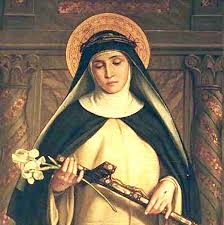 We look to the saints for inspiration. Men and women living ordinary lives, which are eventually recognized as being extraordinary, bring hope and become models for us. As we consider St. Catherine of Siena, you might wonder what a woman born in 1347 in Siena, Italy, and named a Doctor of the Church in 1970, has to offer us today.
We look to the saints for inspiration. Men and women living ordinary lives, which are eventually recognized as being extraordinary, bring hope and become models for us. As we consider St. Catherine of Siena, you might wonder what a woman born in 1347 in Siena, Italy, and named a Doctor of the Church in 1970, has to offer us today.
Catherine was the 24th of 25 children in her
family.[1] (Her twin sister died soon after birth.) Her family had economic means but were not seen as people of influence. She was barely literate, which makes her letter-writing and Dialogues all the more impressive. Most often, she had a scribe assist her. Catherine found herself not fitting into the traditional roles expected for women during her time. Neither marriage nor the cloistered life fit how she was called to serve God. In a teenage outburst, she cut her hair off, making herself unsuitable for marriage. She cloistered herself in a room in her family home, which wasn’t an easy task with so many siblings. This intense time of prayer helped her to find what she was really meant to do in life. She joined the mantelletta, a group of lay women who were widows that lived out their call to Dominican life in their own homes. (Today, many religious communities have “associates” or “affiliates” which are lay people who live a similar calling to the spirituality of a religious community, but as lay people who may or may not be married.)
An important detail about the life of Catherine, is that in 1348, the Bubonic Plague started spreading through cities in Italy. Quarantines were mandated in port cities, often for 40 days. Although the cause of the plague wasn’t known, it was evident that close contact spread the disease. [2] The work of Catherine, as one of the mantelletta, was to care for the sick and poor. This work was dirty and dangerous. Catherine took time to overcome her own disgust at seeing the wounds of others, eventually developing a deep compassion for those that were hurting the most. Raymond of Capua, Catherine’s spiritual director and scribe, wrote that God spoke the following to Catherine:
"I have no intention whatever of parting you from myself, but rather of making sure to bind you to me all the closer by the bond of your love and your neighbor. Remember that I laid down two commandments of love: love of me and love of your neighbor. On these two commandments, as I myself bore witness, ‘depend the Law and the Prophets.’ It is the justice of these two commandments that I want you to fulfill. On two feet you must walk my way, on two wings you must fly to heaven." [3]
This call from God enabled Catherine to balance her desire for God with the real needs of serving the community. Both contemplation and action were necessary to do the work of the time.
In the United States, Catholics, specifically religious communities, were often the ones to found health care facilities, especially for the most vulnerable. In 1823, the first university-affiliated infirmary, at the University of Maryland, was run by Sisters of Charity. Women religious, following in the footsteps of Catherine, served during the Civil War as nurses, cared for people with smallpox, founded the first Cancer hospice, and were leaders in the care of HIV/AIDS patients.[4] Today, there are 668 Catholic hospitals in the U.S., with Catholics working at many other hospitals as well. Most are now staffed by lay men and women, although there are still sisters, brothers and priests who work as doctors, nurses, chaplains and administrators at hospitals and other health care facilities.
During this current COVID-19 Pandemic, Catherine, herself a lay woman, provides a model for Catholic health care providers. In her bravery and compassion, she didn’t turn away from those that were desperately in need of care. On this Feast Day of St. Catherine, may we offer our gratitude to all those who continue this ministry to the sick and dying, fulfilling their calling from God to be compassionate healers and companions to those most in need.
[1] Background information on Catherine of Siena is taken from (Rakoczy IHM 2006) and (Borgman 2001).
[2] (Roos 2020)
[3] (Dominican Sisters, St. Mary of the Springs, Columbus, Ohio, et. al. 2005)
[4] (Sulmasy 1997)
Bibliography
Borgman, Erik. 2001. Dominican Spirituality. London: Continuum.
Dominican Sisters, St. Mary of the Springs, Columbus, Ohio, et. al. 2005. Dominican Praise: A Provisional Book of Prayer for Dominican Women. United States of America: Dominican Sisters.
Rakoczy IHM, Susan. 2006. Great Mystics and Social Justice: Walking on the Two Feet of Love. Mahwah: Paulist Press.
Roos, David. 2020. "Social Distancing and Quarantine Were Used in Medieval Times to Fight the Black Death." History. March 27. Accessed April 22, 2020. https://www.history.com/news/quarantine-black-death-medieval.
Sulmasy, Daniel P. 1997. "Bulletin of the History of Medicine." John Hopkins University Press. Fall. Accessed April 22, 2020. https://muse.jhu.edu/article/3917.

 Sr. Jenn Schaaf, O.P., D.Min.
Sr. Jenn Schaaf, O.P., D.Min.


